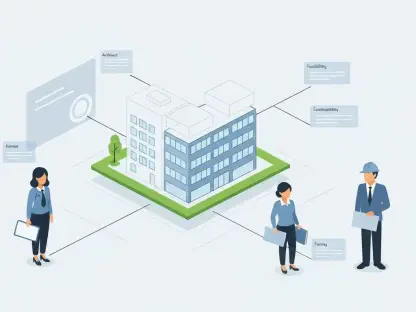The recent analysis of U.S. Census Bureau data by the Associated Builders and Contractors (ABC) paints a detailed picture of the current state of the nonresidential construction sector, highlighting the critical role of federal infrastructure funding during a challenging economic period. Nonresidential construction spending experienced a slight rise of 0.1% in September, reaching a seasonally adjusted annual rate of $1.22 trillion. This modest uptick is largely attributed to a 0.4% rise in public sector projects. In contrast, private nonresidential spending saw a small decline of 0.1%. The data underscores the significant contributions of public sector projects in sustaining construction activity amid a downturn in the private sector, which is grappling with the effects of high borrowing costs and restricted credit conditions.
Federal infrastructure projects have been pivotal in maintaining overall construction momentum. Spending on highway and street construction, for instance, increased to $141.95 billion, marking a 1.5% rise over the past year. Additionally, transportation project expenditures surged 7.2% year-over-year, reaching $70.13 billion. These figures illustrate the essential role that federal funding plays in counterbalancing the decline in private sector investment. Public spending has outpaced private investment growth over the past year, with a 7% rise in public expenditures compared to a 3.5% increase in private spending. Despite the private sector’s contraction, there is cautious optimism for a future rebound.
The Role of Public Sector Investment
Public sector investment has been the backbone of nonresidential construction activity in the United States during this period of economic uncertainty. Anirban Basu, ABC’s chief economist, notes that private nonresidential construction spending remains just below the historical high recorded in June. He predicts that as borrowing costs decrease and lending standards loosen, private sector contributions will recover. This optimism for a rebound is bolstered by ongoing manufacturing megaprojects and robust backlog levels in the industry. Basu’s analysis indicates that the private sector, while currently struggling, is poised for improvement given the right financial conditions.
An exemplary case of positive movement within the private sector is data center construction, which showed a 0.6% monthly increase and a staggering growth of nearly 48% over the past year. This sector’s resilience showcases the potential for recovery and growth in other private nonresidential construction areas. Meanwhile, public sector projects remain a crucial support system. The public sector’s focus on infrastructure, including highways, streets, sewage, waste disposal, and water supply, has been critical in sustaining construction activity. This support has highlighted the economic reliance on federal funding to keep the construction sector afloat, particularly when private investments wane.
Private Sector Challenges and Opportunities
The private sector faces significant challenges due to high borrowing costs and stringent credit conditions, which have led to a decline in investment. Commercial construction, including retail and warehouse projects, plummeted to $125.3 billion, representing a 13.3% annual drop. Despite this downturn, the manufacturing sector offers a glimmer of hope. Manufacturing construction spending reached $235.35 billion in September, indicating a 20.5% annual increase. This growth points to the potential for a private sector rebound, driven by substantial investments in manufacturing and data centers.
The cohesive narrative from the data underscores the critical role of federal funding in sustaining nonresidential construction activity amid private sector challenges. Federal investments in essential infrastructure projects have provided a solid foundation for the construction industry. This ongoing support highlights the economic reliance on public funds to maintain construction momentum. While private sector spending has contracted, the positive trends in certain areas like data centers and manufacturing hint at a potential recovery. As financial conditions improve, the private sector’s contribution to nonresidential construction is expected to rebound, complementing the sustained efforts of public sector investments.
Future Prospects and Economic Reliance
An analysis of U.S. Census Bureau data by the Associated Builders and Contractors (ABC) shows that federal infrastructure funding has been crucial for the nonresidential construction sector during a tough economic period. In September, nonresidential construction spending rose slightly by 0.1%, reaching a seasonally adjusted annual rate of $1.22 trillion. This increase was mainly due to a 0.4% rise in public sector projects, while private nonresidential spending dipped just 0.1%. The data highlight how public sector projects have been vital in maintaining construction activity as the private sector struggles with high borrowing costs and limited credit.
Federal infrastructure projects have significantly influenced overall construction momentum. Spending on highway and street construction grew to $141.95 billion, a 1.5% increase over the past year. Similarly, transportation project spending jumped 7.2% year-over-year to $70.13 billion. These figures emphasize the critical role of federal funding in offsetting the decline in private investment. Over the past year, public expenditures grew by 7%, outstripping the 3.5% rise in private spending. Despite challenges in the private sector, there is cautious optimism for a future recovery.









